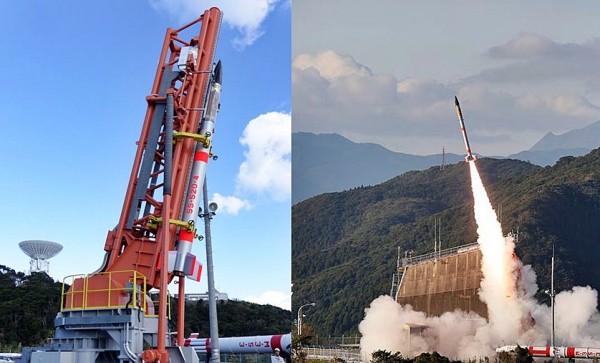Game Changing Japanese Mini-rocket Fails First Launch; Promise of Cheaper Flights Remains
| Arthur Dominic Villasanta | | Jan 17, 2017 04:42 AM EST |
(Photo : JAXA) SS-520 F4 on its launch platform (left) and during its maiden launch.
Japan's first attempt to launch the world's smallest launch vehicle failed, but the promise of spaceflights for small satellites costing up to 90% cheaper than today's mammoth launch costs remains.
The weapon Japan is using in an attempt to change the face of the commercial launch industry is a rocket named SS-520 F4. The rocket was developed by JAXA (Japan Aerospace Exploration Agency) to meet the growing global demand for inexpensive launch vehicles designed to orbit small satellites such as cube satellites or CubeSats.
Like Us on Facebook
The cost of building the rocket, including the launch cost, came to a mere $4.35 million, according to JAXA. In contrast, it costs $61million alone to launch a SpaceX Falcon 9 without the re-usable first stage. With the re-usable first stage, the cost of a Falcon 9 launch should plummet to $43 million.
Falcon 9 is the cheapest launch vehicle on the world commercial launch market. Falcon 9, however, is a far larger vehicle at 70 meters tall and can carry far heavier payloads than the SS-520 F4.
The SS-520 F4, which stands only 10.7 meters (35 feet) tall, is a "mini rocket" described as the world's smallest satellite launch vehicle. JAXA described vehicle as a very small three-stage rocket developed from the SS-520, a two-stage sounding rocket.
The very smallness of the SS-520 F4, however, confers on it the potential to reduce the cost of sending small satellites into low Earth orbit by as much as 90%. The rocket was launched from the Uchinoura Space Center in southern Japan at 8.30 a.m. on Jan. 15.
"The first stage of the rocket's flight went as planned. However, we were unable to receive (data) from the unit as it continued the flight," said JAXA.
The rocket then stopped sending data back to mission control soon after it left the ground. As a result, JAXA decided to abort the mission, causing the rocket to crash into the sea with its payload.
Lost with the rocket was its sole payload, the TRICOM-1 nano-satellite weighing only three kilograms developed by the University of Tokyo and designed to take high-quality images of the Earth. The satellite was to have been taken into low Earth orbit if the flight had been successful.
JAXA said it needs to first investigate the cause of the failure, but wants to maintain the existing policy of using commercial off-the-shelf equipment to build the rocket.
SS-520 F4 was designed with help from Canon Electronics and used parts from consumer electronics devices such as circuit boards and mobile phones.
TagsJapan, SS-520 F4, jaxa, CubeSats, spacex falcon 9, Uchinoura Space Center, TRICOM-1 nano-satellite, University of Tokyo
©2015 Chinatopix All rights reserved. Do not reproduce without permission
 Russia again Successfully Tests an Anti-Satellite Weapon in Space
Russia again Successfully Tests an Anti-Satellite Weapon in Space China Poised to Attain 25 Successful Satellite Launches in 2016; a New National Record for a Single Year
China Poised to Attain 25 Successful Satellite Launches in 2016; a New National Record for a Single Year SpaceX will Dominate World Internet with Plan to Launch 4,425 Internet Satellites
SpaceX will Dominate World Internet with Plan to Launch 4,425 Internet Satellites US has Space Defense Plan to Protect Satellites from Chinese and Russian Attacks
US has Space Defense Plan to Protect Satellites from Chinese and Russian Attacks
EDITOR'S PICKS
-

Did the Trump administration just announce plans for a trade war with ‘hostile’ China and Russia?
-

US Senate passes Taiwan travel bill slammed by China
-

As Yan Sihong’s family grieves, here are other Chinese students who went missing abroad. Some have never been found
-

Beijing blasts Western critics who ‘smear China’ with the term sharp power
-

China Envoy Seeks to Defuse Tensions With U.S. as a Trade War Brews
-

Singapore's Deputy PM Provides Bitcoin Vote of Confidence Amid China's Blanket Bans
-

China warns investors over risks in overseas virtual currency trading
-

Chinese government most trustworthy: survey
-

Kashima Antlers On Course For Back-To-Back Titles
MOST POPULAR
LATEST NEWS
Zhou Yongkang: China's Former Security Chief Sentenced to Life in Prison

China's former Chief of the Ministry of Public Security, Zhou Yongkang, has been given a life sentence after he was found guilty of abusing his office, bribery and deliberately ... Full Article
TRENDING STORY

China Pork Prices Expected to Stabilize As The Supplies Recover

Elephone P9000 Smartphone is now on Sale on Amazon India

There's a Big Chance Cliffhangers Won't Still Be Resolved When Grey's Anatomy Season 13 Returns

Supreme Court Ruled on Samsung vs Apple Dispute for Patent Infringement

Microsoft Surface Pro 5 Rumors and Release Date: What is the Latest?










